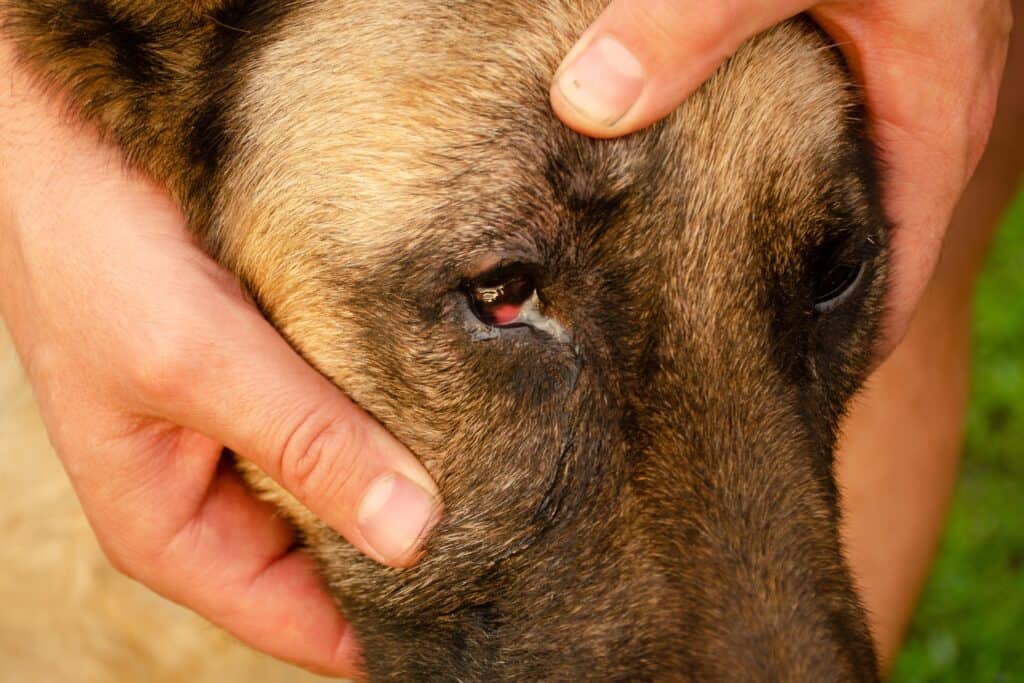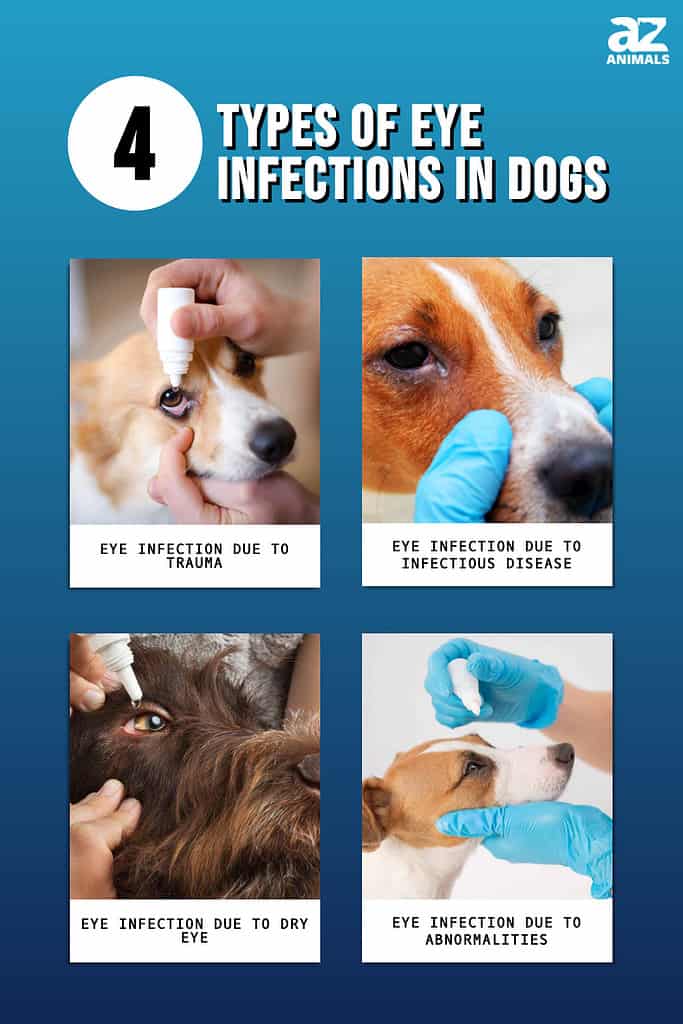There’s nothing sweeter than looking down at your canine companion, to see her gazing up at you lovingly. But what happens when you notice her eyes are red and inflamed? If this has recently happened to you, you’re most likely worrying about your beloved dog. You’re wondering how to deal with eye infections in dogs, as you want to help your fur baby.
We want to offer you the tools needed to care for your dog’s eye infection. We discuss everything you need to know below! This article covers the most common types of eye infections in dogs and how you can help your pup!
What Is an Eye Infection in Dogs?

An eye infection in dogs occurs when the eye is exposed to any type of harmful bacteria, virus, or fungus.
©Aritel/Shutterstock.com
Let’s first introduce you to the core details of a canine eye infection. An eye infection in dogs occurs when the eye is exposed to any type of harmful bacteria, virus, or fungus. These agents can impact all parts of the dog’s eye, ranging from the cornea to the eyelids. Once these agents are introduced to the eye, a dog can then develop a painful eye infection.
Common Eye Infection Symptoms in Dogs
It’s good to know what symptoms to be on the lookout for! To make sure you can offer your dog the care he needs, here are some of the most common symptoms:
- Redness and irritation of the eye
- Watery eyes
- Eye discharge
- Crusting around the eye
- Swelling around the eye
- Frequent pawing at the eye and face
- Squinting of the eyes
- Sensitivity to light, such as squinting when in the sun
- Holding the eye closed
- Facial sensitivity
- Change in eye appearance such as cloudiness or any obvious scratches
If you notice any of the above symptoms, then your canine friend could have some form of eye discomfort. We suggest keeping a close eye on your little one. If symptoms last for more than 12 hours, then it’s likely time to reach out to your vet for guidance.

Are Eye Infections in Dogs a Big Deal?
People also deal with occasional eye irritation from time to time. You may wonder if an eye infection is anything to worry about in dogs. Though it may seem like nothing to worry about, eye infections in dogs are not something to take lightly.
Eye infections in dogs can be extremely painful, even if their symptoms seem minor. Eye infections can cause symptoms ranging from constant burning to stabbing pains. And we never want our canine friends to struggle in this way. Our dogs are also unable to voice the pain they are experiencing. It’s up to us to assess their symptoms and seek relief. There’s simply no way to know just how severe their pain is.
There is also a risk of serious eye damage if the infection is not treated promptly and effectively. This eye damage can be irreversible in some cases. And some dogs will even lose their eyes due to untreated infections. By getting them assessed by a vet from the moment their symptoms develop, your pup has a better chance of avoiding permanent eye damage.
4 Types of Eye Infections in Dogs

Dogs can develop eye infections due to trauma, infectious illness, dry eye, and eye abnormalities.
©Jus_Ol/Shutterstock.com
Now that you have a better understanding of eye infections in dogs, it’s time to discuss the four types of eye infections you may see in your furry friend. Ranging from infectious disease to eye trauma, let’s break down everything you need to know!
Eye Infection Due to Trauma
A common cause of eye infection in dogs is trauma to the eye. Our canine companions don’t understand the importance of protecting their eyes from harm, causing them to fall victim to eye injuries more often than humans do. Dogs can injure their eyes by accidentally scratching their eye, getting scratched by other animals, accidentally poking their eyes with sticks or other sharp objects, and many other common mishaps.
Once a dog does harm their eye in any way, this will often lead to significant discomfort. Eye injuries are highly irritating, so this can cause the dog to scratch their eye in search of relief. The frequent eye scratching will only lead to more irritation, and it will soon introduce bacteria from the paws into the eye. Once bacteria makes its way to the injured eye, an eye infection will soon develop.
Eye Infection Due to Infectious Disease
There are many infectious viruses and bacteria that can impact a dog’s eye health. Most of these illnesses are highly infectious respiratory illnesses, and they can cause symptoms ranging from sneezing to eye discharge. These agents can lead to significant irritation of the canine eye throughout the process, eventually leading to a painful infection in the eye. Some of the most common infectious causes of eye infections in dogs include canine distemper, kennel cough, canine adenovirus, and different forms of mycoplasmas.
Eye Infection Due to Dry Eye
Dry eye in dogs, or keratoconjunctivitis sicca, can often lead to painful eye infections in dogs. Dry eye in dogs is a condition in which the eyes do not produce an adequate amount of tears, often leading to inflammation of the cornea and the surrounding tissues. The irritating dryness often causes a dog to paw at their eyes in search of relief, and this can easily lead to an eye infection.
Unlike trauma or infectious illness, dry eye is a lifelong condition that will need to be medically managed in dogs. If it is not managed properly long term, most dogs will continue to experience significant pain and secondary eye infections.
Eye Infection Due to Abnormalities
Some eye infections in dogs are due to abnormalities of the structures within and around the dog’s eye. This includes issues ranging from entropion (which causes the eyelid and eyelashes to flip inward) to masses on the dog’s eyelid, often leading to painful eye irritation and secondary infections. These issues will often need to be corrected in order to bring the dog relief, as they will only lead to more and more irritation over time.
Is Conjunctivitis a Type of Eye Infection for Dogs?
Yes. In fact, it is one of the most common eye infections in dogs. Conjunctivitis is an inflammation of the conjunctiva, the mucus membrane that covers the inside of the eyelids and the eyeball. It is also known as pink eye, and the symptoms are similar to pink eye in humans: redness, inflammation, and eye discharge (may be foul smelling). There could also be other clinical signs: nasal discharge, sneezing, or coughing.
Conjunctivitis can be caused by a bacterial (most common) or viral infection or an allergic reaction to smoke, pollen, perfume, or other irritants. It often involves both eyes, but only one eye may be affected in certain conditions.
Home Care for Eye Infections in Dogs

If your dog will allow you to gently flush their eye, you can do so with saline and soft cotton balls.
©Alexandr Jitarev/Shutterstock.com
Now that you have a better understanding of what causes eye infections in dogs, it’s time to dive into some of the best ways that you can help your furry friend. We should first mention that these are home care methods that you can try in the first 24 hours after noticing their eye irritation, and if their symptoms are still present after 24 hours, then we suggest having them assessed by a vet. These methods will not treat an eye infection in dogs, but they can prevent further damage to the eye while you monitor the situation.
We should also mention that if the infection is so painful that you are unable to clean up the eye yourself at home, then we suggest having them seen by a veterinarian as soon as possible. Now that you understand that these are the only methods to apply when you first notice eye irritation, and they are not a treatment in themselves, let’s dive into some of the safe at-home care methods.
Cleaning Away Any Eye Discharge
The first thing you can do when trying to assess your dog’s irritated eye is to clean away any eye discharge or crusting with a warm washcloth. By removing any discharge or crusting around the eye, you can better assess the eye for any obvious sign of trauma or irritation. Just be sure to do this gently, as you do not want to cause any further trauma to the area.
Flushing The Eye with Saline
If your dog will allow you to gently flush their eye, you can do so with saline. Pure saline can be found at most drugstores and pharmacies, and it should allow for irritation-free flushing without any significant pain or burning. A five-second flush in each eye should be sufficient, and you can clean away any discharge with a cotton ball or soft rag. Just be sure that the solution you are using is indeed saline, and does not contain any additional ingredients.
Putting an E-Collar on Your Dog
The most important thing to do when you notice any eye irritation in your dog is to prevent them from scratching or pawing at the eye. Scratching at the eye will only lead to more eye damage, and it can also introduce bacteria from their paws into the eye itself. If your dog is pawing at their face due to eye irritation, we always suggest putting an e-collar on them to be safe.
My Dog Has an Eye Infection – What Should I Do?
While the home remedies we discussed above are acceptable as a first line of defense when you notice eye irritation in your pup, they will not treat eye irritation due to infection. If your canine companion is still experiencing eye irritation after 24 hours of the onset of their symptoms, then we always suggest reaching out to your vet for guidance.
If your dog has developed an eye infection due to any of the factors we discussed above, then most dogs will need some form of medical treatment. At the least, most dogs will need antibiotic therapy to treat the eye infection. In addition to treating the infection, your vet may need to address any trauma to the eye itself, as well as any underlying factors that have led to the eye infection.
Eye infections in dogs are always something you should take seriously, as they can quickly lead to irreversible damage for the dog affected. In addition to the damage an eye infection can cause, they can be excruciating for a pup to endure. This is why we always suggest having them assessed by a vet if their eye irritation lasts for more than 24 hours, as waiting any longer can increase the risk of complications.
Summary of 4 Types of Eye Infection in Dogs
| Type of Eye Infection | Possible Causes | |
|---|---|---|
| 1 | Eye Infection Due to Trauma | Accidentally scratching of the eye |
| 2 | Eye Infection Due to Infectious Disease | From bacteria or virus |
| 3 | Eye Infection Due to Dry Eye | A chronic hereditary condition |
| 4 | Eye Infection Due to Abnormalities | Entropion (which causes the eyelid and eyelashes to flip inward) or masses on the dog’s eyelid |
How Do I Know if my Dog has Viral or Bacterial Conjunctivitis?

If your dog’s eyes are red or it is pawing at them, it may have an eye infection.
©iStock.com/PavelRodimov
Should your dog have an eye infection, you may be able to tell which type it is by the color of the discharge at the site. A bacterial infection will be exhibited by the presence of a green and/or yellow discharge while a viral infection will be exhibited by a cloudy white, yellow, or green-tinged mucus-like discharge coming from the affected area.
If your dog’s eyes are leaking with a clear or white discharge, this is commonly associated with allergies and although you should still address this to help them be more comfortable, it isn’t as much a cause for concern as conjunctivitis. When your dog is exhibiting any symptoms that are not normal, you should always take them to see their veterinarian.
The photo featured at the top of this post is © iStock.com/Daniel de Andres Jimenez
Ready to discover the top 10 cutest dog breeds in the entire world?
How about the fastest dogs, the largest dogs and those that are -- quite frankly -- just the kindest dogs on the planet? Each day, AZ Animals sends out lists just like this to our thousands of email subscribers. And the best part? It's FREE. Join today by entering your email below.
Thank you for reading! Have some feedback for us? Contact the AZ Animals editorial team.






